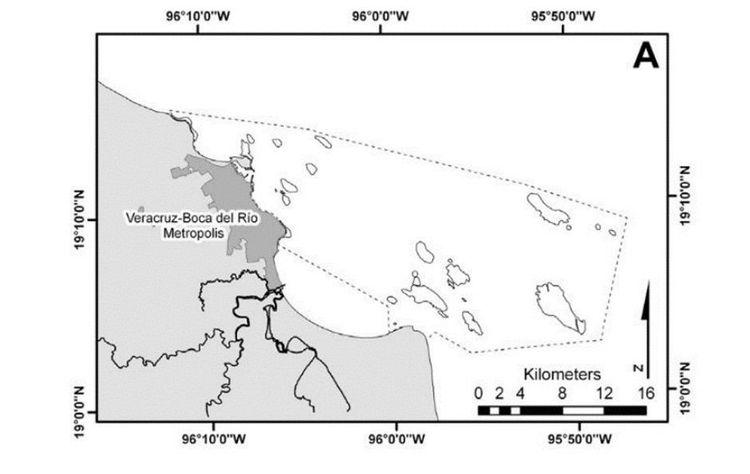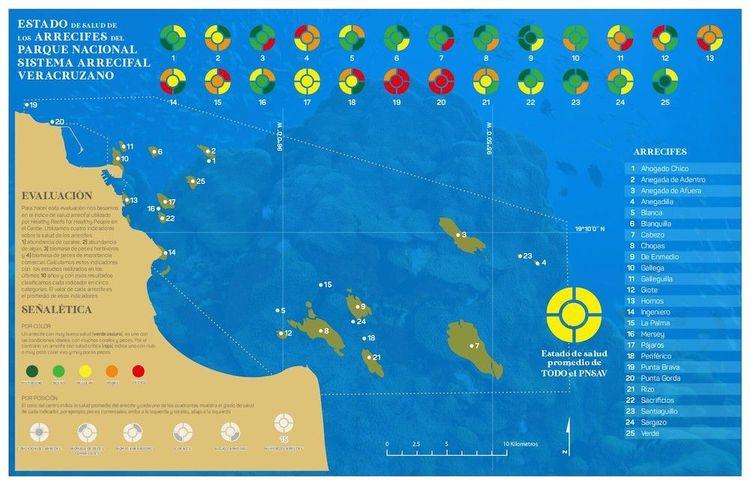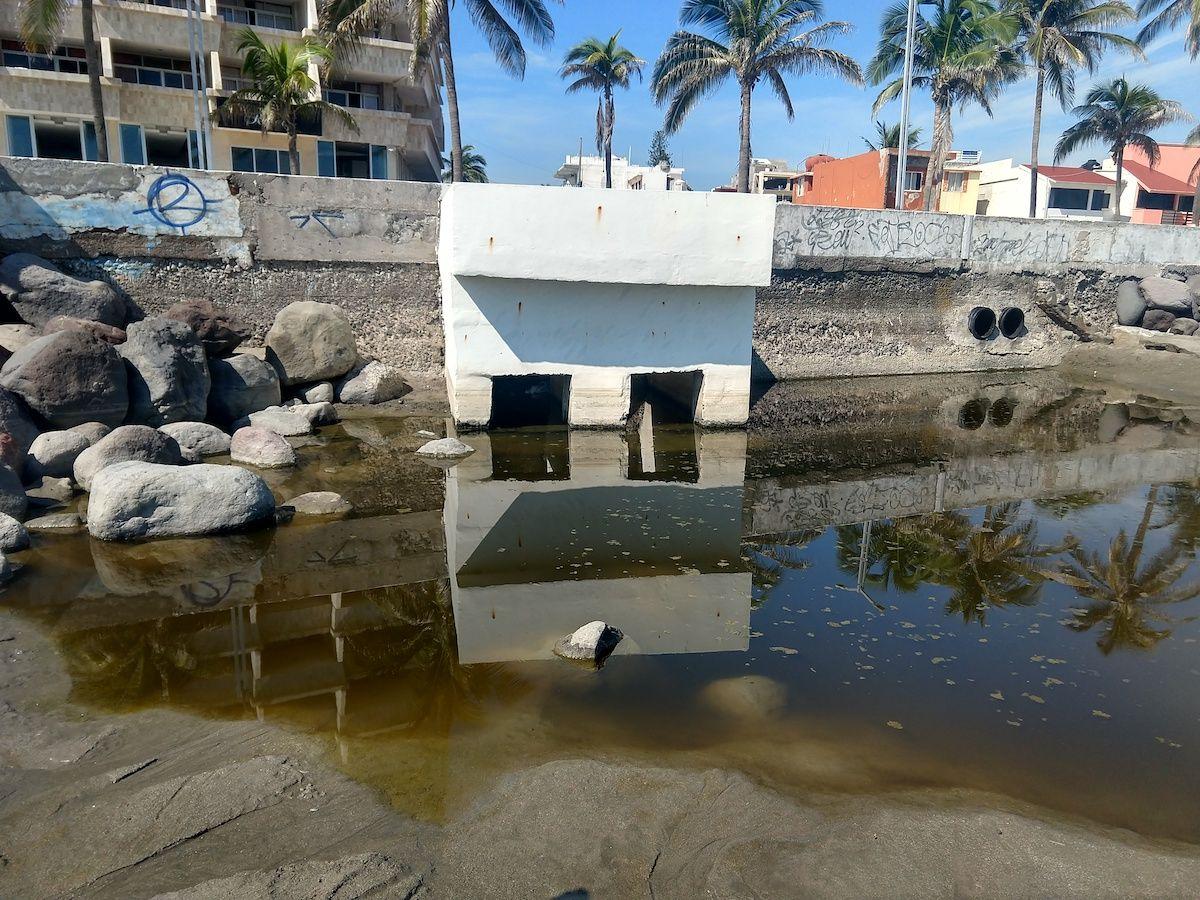It's a fetid smell, something like a combination of the smell of a pipe and a dead animal, said the fisherman Bernardo Hernández. It is wastewater from the urban area of the Veracruz-Boca del Rio corridor, which is discarded directly into the sea, a few meters from the largest coral reef system in the Gulf of Mexico.
They are not one or two wastewater discharge points, but almost 100, explained Cristopher González Baca, director of the Veracruz Reef System National Park, under the National Commission for Protected Natural Areas (Conanp).
The waters come out of the storm drain into the sea, but not all of it is rainwater, because, in addition to the bad smell, they come out even when there is no rain.
On a tour carried out by National Park personnel along 75 kilometers of coastline, carried out in October 2021, during a rain-free season, 210 drainage discharge points were found, among which they identified at least 44% with sewage outlets.
It is not known exactly who discharges their wastewater into the storm drain, which then ends up in the sea, but the situation represents a serious problem, both for the reefs and for the marine species that live near the coast, said González Baca.
The Veracruz Reef System is a Protected Natural Area enacted in August 1992. It covers an area of 65,504 hectares. This perimeter is home to at least 37 species listed in the Official Mexican Standard 059-Semarnat-2010, as they are considered endangered, including corals such as Elk Horn, Deer Horn, Sea Fan and Great Star Coral.
Corals, the main reef-formers, are colonial animals made up of small organisms called polyps, which settle on a base of calcium carbonate. Thus, depending on the species, they adopt different shapes and sizes.
Coral reefs constitute one of the most biologically diverse ecosystems in the marine environment. They are home to a great diversity of flora and fauna, providing shelter, protection and food for fish, mollusks and crustaceans, some of them of commercial interest.
They also act as a coastal protection barrier against severe storms and hurricanes.
The Veracruz Reef Park is made up of 28 reef formations, of which at least six are close to the coast, where sewage flows. “There are some reefs less than 800 meters from where sewage falls,” said Cristopher González Baca.

Corals need optimal conditions to survive, in terms of depth, light, temperature and high oxygen concentrations, according to the explanation of Melina Soto, representative in Mexico of the Healthy Reefs Initiative (HRI).
For adequate oxygen concentrations to exist, water must be low in nutrients. Wastewater, on the other hand, is overloaded with nutrients that promote the growth of fleshy algae, which gain ground from corals, suffocate and kill them.
The Directorate of the Veracruz Reef System National Park conducted a study to determine the health of the reefs that make up this protected area, based on the evaluation model applied by HRI in the Mesoamerican Reef.
The results showed that the reef sites close to the coast in the Veracruz-Boca del Rio corridor, the closest to the wastewater discharge points, are those with the highest degree of deterioration.

Graphic: Veracruz Reef National Park
Last February, the National Park Advisory Council filed a formal complaint with the Federal Attorney's Office for Environmental Protection (Profepa), against anyone or those responsible for discharging untreated wastewater into the storm drain.
The agency reported that the complaint was received, but it has not reported on the field inspection or sanctions against those responsible, Cristopher González said.
The local authorities responsible for the operation and maintenance of drainage systems are the private company Grupo Metropolitano de Agua y Saneamiento, in the municipality of Veracruz, and the public agency Water Company of the Municipality of Boca del Río.
Contaminated rivers, another problem
Veracruz's reefs are not only exposed to sewage, but also to the contaminated rivers that flow into the area. An example is the Jamapa River, which meets the sea on the side of downtown Boca del Rio.
This river crosses the industrial area for the production of cane and alcohol. When it comes into contact with the ocean, it forms a cream of turbid water that extends for several kilometers.
“Before, it reached where the river flowed, you could see the difference between the water by about six or seven meters and then it would dilute. Not right now, the pollution reaches 20 miles into the sea (32 kilometers). Pesticides, herbicides, toxins, we don't know what it is, but it all comes at once,” said Bernardo Hernández.
In addition to contaminated water, rivers carry organic waste and plastics.
“There's nowhere to fish anymore”
The change in water conditions on the coast of the Veracruz-Boca del Rio conurbated area is suffocating the fishing sector, as the activity is increasingly risky and less profitable.
Before, they found product nearby. Now, due to pollution, they have to go more than 30 kilometers out to sea, said Hernández, who also chairs the Veracruz Fishermen's Federation.
“There's nowhere to fish anymore. This is causing the crisis, the bankruptcy of fishing in Veracruz, to accelerate faster. Going outside today doesn't guarantee you'll catch. You risk going out 20 miles, which is where the water that is not so contaminated can be, and that generates an expense of 3,000 pesos, but there are days when not even 500 are taken out. That becomes losses and people choose to do something else, a lot of people are leaving the activity,” he said.
The fisherman, with 40 years in the trade, pointed out that together with his colleagues in the profession, they see daily malpractices that directly impact coastal ecosystems, but they are not heard.
The Federation of Fishing Cooperatives proposes to form monitoring committees among its own members.
“We want it to be legal, in form, so that the complaints we make are taken into account, logically all supported, right now no one pays attention to us,” he said.
A Story of Resilience
The reefs of Veracruz have a history of resilience. Unlike the reefs of the Mexican Caribbean, where human activity intensified just 50 years ago, with the founding of Cancun, the corals in this area have resisted human activity for more than five centuries, since the founding of the Port.
“Surprisingly, we found better preserved reefs than in the Caribbean, which have been exposed for many years, in fact, with the founding of the city, corals were being extracted for use as construction material. What we have right now are very resilient corals, which have already withstood so many impacts,” said Cristopher González.
Research published in 2013 by academics Verónica Valadez Rocha and Leonardo Ortiz Lozano, from the Universidad Veracruzana, analyzes the relationship between ports and reef areas, mainly because reefs provide protection to vessels against extreme weather events such as storms and hurricanes.
With the support of aerial photographs and maps from the 19th and early 20th centuries, experts identified that port expansion in Veracruz has caused the direct loss of 50% of the reef strip near the port.
The research was published, they say, on the “eve” of the expansion of the New Port.
On November 29, 2012, the Ministry of Environment and Natural Resources (Semarnat) published a decree to reduce the protected area of the Veracruz Reef System National Park by more than 12 thousand hectares, to allow for the construction of the New Port.
The works began in 2016 and progressed with the installation of a giant breakwater over the Punta Gorda reef site, but last February the Supreme Court of Justice of the Nation upheld a group of environmentalists, so that the infrastructure that was planned on the La Gallega site was temporarily stopped.
In a 100-year projection, the academics pointed out that this project will repeat the same patterns of environmental impact as those that occurred a century ago.



Comentarios (0)